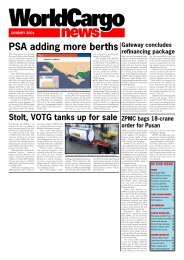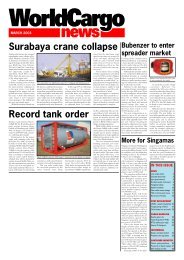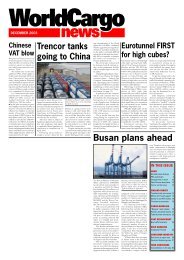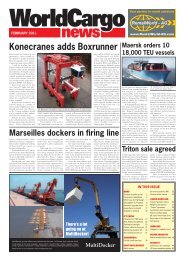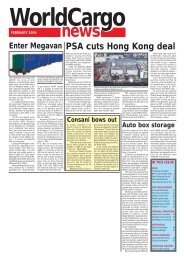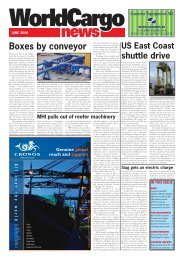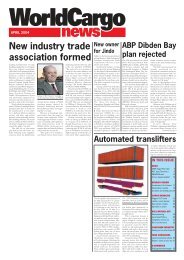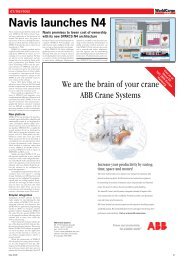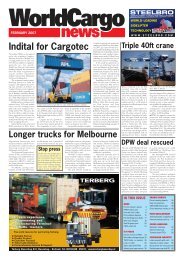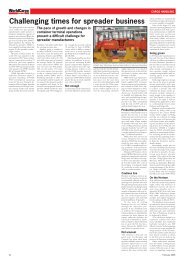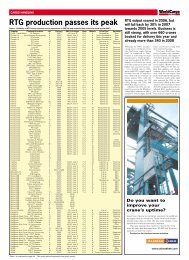US-built box crane - WorldCargo News Online
US-built box crane - WorldCargo News Online
US-built box crane - WorldCargo News Online
Create successful ePaper yourself
Turn your PDF publications into a flip-book with our unique Google optimized e-Paper software.
FOREST PRODUCTS/CARGO HANDLING<br />
Tapping into the global reach of lift trucks<br />
In a paper launching it new reach stacker,<br />
Mitsubishi Heavy Industries (MHI) calculates<br />
that the global market for reach<br />
stackers grew from 200 to 1300 units/<br />
year in the decade to 2002 - a steeper<br />
growth curve than containerisation itself.<br />
Its figure is much higher than the ><br />
800 units (excluding Kalmar RTCHs)<br />
reckoned for 2004 output in <strong>WorldCargo</strong><br />
<strong>News</strong>, December 2004 edition. Although<br />
the market has grown again this year, it is<br />
still thought to be under 1000 units.<br />
However, this equipment area is notoriously<br />
difficult to survey accurately. It<br />
the shrink wrap is in place, the bar code<br />
is automatically applied.<br />
When the shrink wrapping contracts<br />
to hold the cargo in place, the bar code<br />
label crinkles. It can normally be read<br />
manually if it is smoothed out, but not<br />
automatically. Accordingly the scanning<br />
system rejected these pallets. Once the<br />
shipper was aware of the problem, different<br />
procedures were put in place and it is<br />
no longer a problem.<br />
The increasing popularity of the reach<br />
stacker has encouraged more lift truck<br />
manufacturers to enter the market<br />
may be the case that established players<br />
deliberately understate their estimates of<br />
market size when talking on the record,<br />
in order to discourage new entrants. For<br />
certain, <strong>WorldCargo</strong> <strong>News</strong> is not in a position<br />
to say that it knows better than MHI.<br />
Whatever the exact numbers, most of<br />
the growth has been captured by European<br />
suppliers. Asian FLT manufacturers<br />
tended to treat the container handling<br />
market as the heavy segment of their range<br />
and were slow to embrace the reach<br />
stacker. This is changing, however. Reach<br />
stacker manufacturers in China and India<br />
report strong order books for local<br />
customers, while two manufacturers in<br />
Japan are looking to the export market.<br />
Boom up in India<br />
Indital Construction Machinery (ICM)<br />
has been building reach stackers at it facility<br />
in Bangalore since 1989. Managing<br />
director Ravi Kumar said demand has<br />
more than doubled in the last 12 months<br />
from 40 units in 2003/04 to over 90 units<br />
this year (a figure some think too high).<br />
Previously ICM targeted exports and<br />
sold one machine to a customer in Tanzania<br />
but it is now struggling to meet<br />
domestic demand alone. It has <strong>built</strong> up<br />
capacity from 30 units/year to 50 and a<br />
second expansion is under way to boost<br />
that to 75 by March 2006. “Even if we<br />
touch this figure, we would not be able<br />
to cater for Indian demand,” says Kumar.<br />
ICM developed its current Contstar<br />
<strong>WorldCargo</strong><br />
news<br />
Former Fantuzzi group CEO Davide<br />
Bertozzi is now with Linde<br />
Auto trailer loading<br />
Another feature of the Tilbury project that<br />
breaks new ground, although using existing<br />
technology, is the Trancel automatic<br />
trailer loading system. It requires specially<br />
modified road trailers, supplied by the<br />
haulier C&H, fitted with a false load floor<br />
into which five recessed channels are incorporated,<br />
each of which has an air-operated<br />
cover.<br />
The trailer load, as requested by the<br />
user who has direct input into the WMS,<br />
is selected from the high bay warehouse,<br />
removed by the stacking <strong>crane</strong>s, transported<br />
by conveyor to the vehicle loading<br />
station and lifted from the conveyor<br />
onto the Trancel loader by the automated<br />
overhead vacuum clamp gantry.<br />
When the load is made up, the road<br />
trailer is backed into position and the tines<br />
of the Trancel device raised and moved<br />
forward into the trailer. These tines are<br />
aligned with the channels in the trailer<br />
floor. At this stage the channels are raised<br />
but when the load is in place, the covers<br />
are lowered to allow the reels to sit on<br />
the trailer floor and the tines removed.<br />
However, unlike the SECU, which sits<br />
on the ground, the trailer has a suspension<br />
system and the Trancel system needs<br />
a fully-aligned and steady base. Accordingly<br />
the trailers are equipped with a fifth<br />
wheel king pin aft of the rear axles that<br />
mate with a standard fifth wheel mounted<br />
at the end of the loading bay. Once the<br />
trailer is locked onto this, the air suspension<br />
is relaxed and the full weight taken<br />
on the rear fifth wheel coupling.<br />
Considerable care must be taken when<br />
reversing the trailer onto the loading bay<br />
as it must be placed at exactly 90 deg. to<br />
the loading dock or else the tines carrying<br />
the reels will not mate fully with the<br />
channels in the trailer floor. As with reversing<br />
the SECU into the discharge bay,<br />
the tractor driver relies on aligning the<br />
trailer with lines painted on the floor. But<br />
in the case of the trailer, he does not have<br />
the advantage of rear steering and relies<br />
on the tractor unit for manouevrability.<br />
Cross-dock<br />
An off-site rail cross-dock facility has also<br />
been constructed to handle both incoming<br />
and outgoing traffic, although as yet<br />
the two planned inboard trains from<br />
Langebrugge with Zeebrugge cargo via<br />
the Channel Tunnel are not yet in the<br />
schedule. Instead, any Zeebrugge import<br />
cargo from Göteborg is transported by<br />
road to Tilbury, although this is considered<br />
a very temporary solution.<br />
The rail cross-dock, located adjacent<br />
to Tilbury’s main container rail terminal,<br />
will serve five weekly trains to Selby,<br />
Knowsley, Deanside and Avonmouth, The<br />
covered platform and rail track is similar<br />
to that at Zeebrugge and features four<br />
dock leveller SECU slots for direct clamp<br />
truck handling plus an automated Trancel<br />
profile inserter to discharge the grey<br />
SECUs. These are then loaded manually<br />
as the UK rail system does not have covered<br />
rail cars capable, as yet, of automated<br />
loading. ❏<br />
KALMAR REACHSTACKERS<br />
NO.1 CHOICE FOR REACHING C<strong>US</strong>TOMER EXPECTATIONS<br />
More operators choose Kalmar Reachstackers than any other make. Why?<br />
Because Kalmar gives them a wider choice of models to perfectly suit their<br />
applications in both toplift and combi-lift combinations. And the reliability, easy<br />
maintenance and outstanding all-round performance of Kalmar Reachstackers<br />
meets their operational expectations every time.<br />
For more information about Kalmar Reachstackers and the full range of worldbeating<br />
container handling technology, visit our website or contact your Kalmar<br />
Representative.<br />
www.kalmarind.com<br />
September 2005 39



